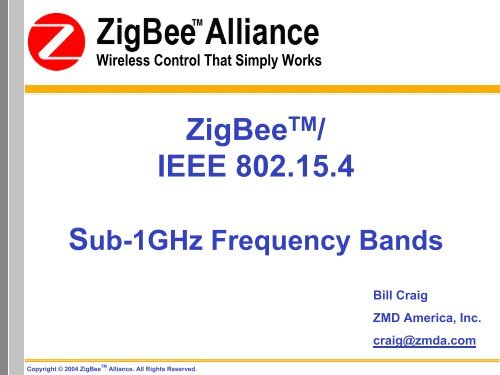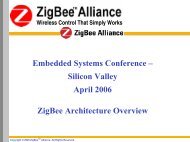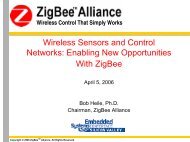IEEE 802.15.4 - ZigBee
IEEE 802.15.4 - ZigBee
IEEE 802.15.4 - ZigBee
Create successful ePaper yourself
Turn your PDF publications into a flip-book with our unique Google optimized e-Paper software.
Wireless Control That Simply Works<strong>ZigBee</strong> TM /<strong>IEEE</strong> <strong>802.15.4</strong>Sub-1GHz Frequency BandsBill CraigZMD America, Inc.craig@zmda.comCopyright © 2004 <strong>ZigBee</strong> TM Alliance. All Rights Reserved.
<strong>IEEE</strong> <strong>802.15.4</strong> Physical LayerAPPLICATION/PROFILES<strong>ZigBee</strong>- Dec 2004<strong>IEEE</strong> <strong>802.15.4</strong>- Approved April 2003APPLICATION FRAMEWORKNETWORK/SECURITYLAYERSMAC LAYERPHY LAYERApplication<strong>ZigBee</strong> Platform StackSilicon<strong>ZigBee</strong> TM Alliance | Wireless Control That Simply WorksCopyright © 2004. All Rights Reserved.2
<strong>IEEE</strong> <strong>802.15.4</strong> Frequency CharacteristicsFrequencyBandCoverageData# ofChannelsRxSensitivityModulation2.4GHzISMWorldwide250kbps16-85dBmO-QPSK868 to870MHzEurope20kbps1-92dBmBPSK902 to928MHzISMAmericas40kpbs10-92dBmBPSK<strong>ZigBee</strong> TM Alliance | Wireless Control That Simply WorksCopyright © 2004. All Rights Reserved.3
PHY Frequency Discriminators■2.4 GHz►Worldwide License Free Operation►250kbps Data Rate■Sub-1 GHz►Americas and Europe License Free Operation►40kbps and 20kbps Data Rates►Transmission Range►Path Loss►Fewer Coexistence Issues<strong>ZigBee</strong> TM Alliance | Wireless Control That Simply WorksCopyright © 2004. All Rights Reserved.4
Transmission Range and Path Loss■Range Determination►Friis Transmission Formula – R = λ/4∏(Pr/Pt) 0.5 for Gt = Gr = 1►Lower Frequencies tend to give greater range.■Path Loss►Path Loss Model - L total = 20 log 10 (f) + N log 10 (d) + L f (n) – 28►RF signals experience path loss penetrating material.►Lower frequencies tend to give lower path loss.Site-General Path Loss Model for 915MHz and 2450MHzf = RF Frequency 915MHz 2450MHzN = Dist. Pwr. Loss for Office Environment 30 30d = Dist. (meters) between Nodes 10 meters 100 metersn = Floors Penetrated 1 1dB Loss at Link Dist. (10 meters) 76.228 84.783dB Loss at Link Dist. (100 meters) 106.228 114.783Path Loss as Function of Frequency = 8.555 dBdoc.: <strong>IEEE</strong> 802.15-00/294r1<strong>ZigBee</strong> TM Alliance | Wireless Control That Simply WorksCopyright © 2004. All Rights Reserved.5
Coexistence■902MHz to 928MHz►Cordless Phones►Proprietary■2402MHz to 2480MHz►Bluetooth►WLAN 802.11b►WLAN 802.11g►WDCT – Cordless Phones►Proprietary►Microwave OvensChairman <strong>IEEE</strong> 802.15 Coexistence Task Group (TG2) - “The potential for interferencebetween different wireless units – using incompatible protocols and in the same frequencyspectrum needs to be investigated and quantified”Senior FCC Official (anonymous) - “Many of these devices use spread spectrum, whichtends to be relatively immune to interference, but as you might expect, if you pack enoughthings close enough together, there’s always the possibility of interference,”<strong>ZigBee</strong> TM Alliance | Wireless Control That Simply WorksCopyright © 2004. All Rights Reserved.6
Summary■<strong>IEEE</strong> <strong>802.15.4</strong> frequency bands provideflexibility and support for the full range of<strong>ZigBee</strong> industrial, commercial, residential,and home markets.■OEMs and manufacturers benefit from thefrequency options provided by the <strong>IEEE</strong><strong>802.15.4</strong> and <strong>ZigBee</strong> standards.■The consumer benefits with an optimized,cost effective product providing:“Wireless Control That Simply Works”.<strong>ZigBee</strong> TM Alliance | Wireless Control That Simply WorksCopyright © 2004. All Rights Reserved.7
QuestionsBill CraigProgram Manager, Wireless CommunicationsZMD America, Inc.craig@zmda.comSensors Expo Booth: 608<strong>ZigBee</strong> TM Alliance | Wireless Control That Simply WorksCopyright © 2004. All Rights Reserved.8







